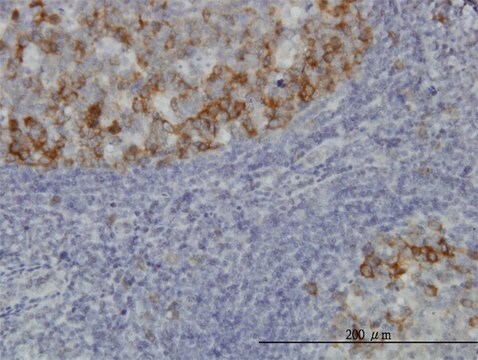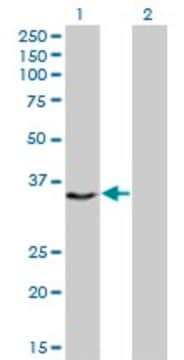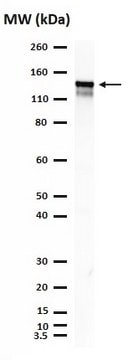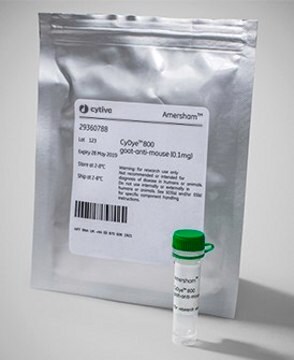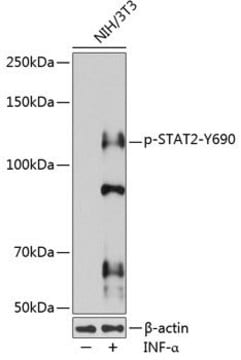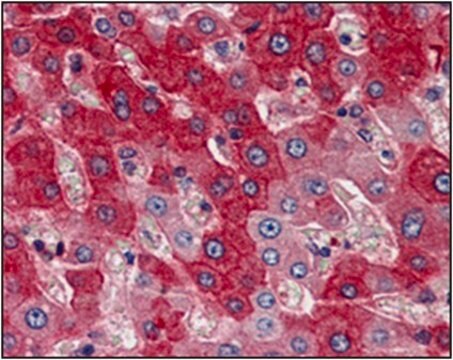MAB3612
Anti-BubR1 Antibody, clone 8G1
clone 8G1, Chemicon®, from mouse
Sign Into View Organizational & Contract Pricing
All Photos(2)
About This Item
UNSPSC Code:
12352203
eCl@ss:
32160702
NACRES:
NA.41
Recommended Products
biological source
mouse
Quality Level
antibody form
purified immunoglobulin
antibody product type
primary antibodies
clone
8G1, monoclonal
species reactivity
human
manufacturer/tradename
Chemicon®
technique(s)
immunocytochemistry: suitable
western blot: suitable
isotype
IgG1
NCBI accession no.
UniProt accession no.
shipped in
wet ice
target post-translational modification
unmodified
Gene Information
human ... BUB1B(701)
General description
The mitotic checkpoint prevents the resulting two daughter cells from having unequal numbers of chromosomes. This condition, known as aneuploidy, is present in almost all cancer cells and may be due to malfunctions in the mitotic checkpoint. BubR1 is a mitotic checkpoint kinase and has been implicated in the metaphase checkpoint control in mammalian cells.
Specificity
Recognizes human BubR1.
Immunogen
Recombinant human BubR1.
Application
Detect BubR1 with Anti-BubR1 Antibody, clone 8G1 (Mouse Monoclonal Antibody), that has been shown to work in WB, ICC.
Western blot using an ECL detection system. Reacts with the ~120 kDa BubR1 protein and higher bands due to hyperphosphorylations.
Immunocytochemistry: 1 μg/mL on tissue culture cells. Suggested fix is 3.5% PBS-buffered paraformaldehyde for 7 minutes. Permeabilization method is 0.2% Triton-X-100 after fixation. Suggested blocking buffer is 10 mM Tris, pH 7.5 with 150 mM NaCl with 0.1% BSA.
Optimal working dilutions must be determined by the end user.
Immunocytochemistry: 1 μg/mL on tissue culture cells. Suggested fix is 3.5% PBS-buffered paraformaldehyde for 7 minutes. Permeabilization method is 0.2% Triton-X-100 after fixation. Suggested blocking buffer is 10 mM Tris, pH 7.5 with 150 mM NaCl with 0.1% BSA.
Optimal working dilutions must be determined by the end user.
Physical form
Format: Purified
Other Notes
Concentration: Please refer to the Certificate of Analysis for the lot-specific concentration.
Legal Information
CHEMICON is a registered trademark of Merck KGaA, Darmstadt, Germany
Not finding the right product?
Try our Product Selector Tool.
Storage Class
10 - Combustible liquids
wgk_germany
WGK 2
flash_point_f
Not applicable
flash_point_c
Not applicable
Certificates of Analysis (COA)
Search for Certificates of Analysis (COA) by entering the products Lot/Batch Number. Lot and Batch Numbers can be found on a product’s label following the words ‘Lot’ or ‘Batch’.
Already Own This Product?
Find documentation for the products that you have recently purchased in the Document Library.
Subcellular localization of the spindle proteins Aurora A, Mad2, and BUBR1 assessed by immunohistochemistry.
Burum-Auensen, E; De Angelis, PM; Schj?lberg, AR; Kravik, KL; Aure, M; Clausen, OP
The journal of histochemistry and cytochemistry : official journal of the Histochemistry Society null
David J Wynne et al.
Molecular biology of the cell, 27(22), 3395-3404 (2016-11-05)
The kinetochore is often depicted as having a disk-like architecture in which the outer layer of proteins, which engage microtubules and control checkpoint signaling, are built on a static inner layer directly linked to CENP-A chromatin. Here, applying three-dimensional (3D)
Linda Clijsters et al.
Cell cycle (Georgetown, Tex.), 13(15), 2370-2378 (2014-12-09)
Sister chromatid separation creates a sudden loss of tension on kinetochores, which could, in principle, re-activate the spindle checkpoint in anaphase. This so-called "anaphase problem" is probably avoided by timely inactivation of cyclin B1-Cdk1, which may prevent the spindle tension
Eric C Tauchman et al.
Nature communications, 6, 10036-10036 (2015-12-02)
During mitosis, duplicated sister chromatids attach to microtubules emanating from opposing sides of the bipolar spindle through large protein complexes called kinetochores. In the absence of stable kinetochore-microtubule attachments, a cell surveillance mechanism known as the spindle assembly checkpoint (SAC)
Erik Voets et al.
Biology open, 4(4), 484-495 (2015-03-10)
When cells enter mitosis, the anaphase-promoting complex/cyclosome (APC/C) is activated by phosphorylation and binding of Cdc20. The RXXL destruction box (D-box) of cyclin B1 only binds Cdc20 after release of the spindle checkpoint in metaphase, initiating cyclin B1 ubiquitination upon
Our team of scientists has experience in all areas of research including Life Science, Material Science, Chemical Synthesis, Chromatography, Analytical and many others.
Contact Technical Service